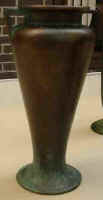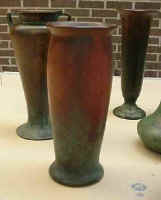©1999-2015
Wisconsin Pottery Association
P.O. Box 705
Madison WI 53701-0705
Clewell Pottery
1906-1965
Canton, Ohio
Presented by Betty Knutzen
February 8, 2000
Betty showed several pieces from her & her husband Dave's collection. Her first Clewell was not a pottery vase, but instead was metal vase. She told of finding it in a garage at an estate sale (Dave got the house that day). To the right is the vase.
Click on any picture to see a larger image & use your browser's back button to return to this page.
The following article appeared in the April 2000 edition of the WPA Press.
At the February WPA meeting we had the pleasure of learning
about Clewell Pottery from Betty Knutzen. Always humble, Betty told us that
before her research for this talk, she didn't know much about Clewell Pottery
herself. However, unlike some of us, Betty does own a few pieces of this unique
pottery, which she and husband Dave shared with the WPA in this February of this
year.
Clewell is one of those potteries for which there is very little printed
information. Betty went back through old journals seeking data for her talk. The
following is a bit of what she learned and presented to the WPA.
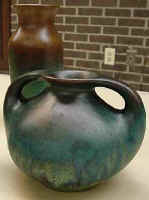 Charles
W. Clewell was a metal craftsman, not a potter. Paul Evans, in his text
"Art Pottery of the United States" said that metal workers and potters
fed on each others' work. Some potteries of the early 1900s featured animals on
their pots, not unlike metalwork. In addition, McCoy and Weller used glazes that
had a metallic look. Rookwood potters and others used metal overlay on standard
glazes. Charles Clewell also mixed pottery and metal, but he was the first to
use an entire metal overlay. Clewell was born in Ohio in 1876. He became
an engraving apprentice, gaining employment with Diebold metalworkers.
Charles
W. Clewell was a metal craftsman, not a potter. Paul Evans, in his text
"Art Pottery of the United States" said that metal workers and potters
fed on each others' work. Some potteries of the early 1900s featured animals on
their pots, not unlike metalwork. In addition, McCoy and Weller used glazes that
had a metallic look. Rookwood potters and others used metal overlay on standard
glazes. Charles Clewell also mixed pottery and metal, but he was the first to
use an entire metal overlay. Clewell was born in Ohio in 1876. He became
an engraving apprentice, gaining employment with Diebold metalworkers.
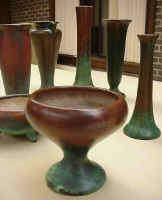 Dick
Sigafoose, in his book entitled "American Art Pottery" (1998) said
that Charles Walter Clewell, of Canton, Ohio, started experimenting with copper,
brass, bronze and silver products in about 1899, producing cast, hand-wrought
and riveted pieces. In 1906 Clewell opened his first business and by 1909 had
developed his metal-on-pottery technique. Clewell accomplished this by appIy a
skin-tight shell, often copper or bronze, over a clay pot. Clewell worked on
this technique for years to perfect it. He was highly secretive about the
process he used, but it appeared to be a form of electroplating. Several other
ceramic and glass factories utilized electroplating during this same time
period.
Dick
Sigafoose, in his book entitled "American Art Pottery" (1998) said
that Charles Walter Clewell, of Canton, Ohio, started experimenting with copper,
brass, bronze and silver products in about 1899, producing cast, hand-wrought
and riveted pieces. In 1906 Clewell opened his first business and by 1909 had
developed his metal-on-pottery technique. Clewell accomplished this by appIy a
skin-tight shell, often copper or bronze, over a clay pot. Clewell worked on
this technique for years to perfect it. He was highly secretive about the
process he used, but it appeared to be a form of electroplating. Several other
ceramic and glass factories utilized electroplating during this same time
period.
In terms of the clay figures utilized for his metal-covered pieces, Clewell is
known to have used ceramics from Ohio potteries such as Owens and Weller.
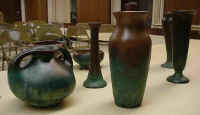 The
idea for the blue-green patinaed pieces that Clewell worked to achieve, is said
to have come from his mother's kitchen. He liked the oxidized look of old metal
and was known to have studied pieces in junkyards. Clewell was especially a fan
of the patina that appeared on copper and bronze. In 1923 Clewell finally
accomplished the color he sought to achieve-a more blue-green colored finish.
His next step was to speed up the process used to achieve this perfect
blue-green, and developed a way to stop the color before it advanced too far.
The
idea for the blue-green patinaed pieces that Clewell worked to achieve, is said
to have come from his mother's kitchen. He liked the oxidized look of old metal
and was known to have studied pieces in junkyards. Clewell was especially a fan
of the patina that appeared on copper and bronze. In 1923 Clewell finally
accomplished the color he sought to achieve-a more blue-green colored finish.
His next step was to speed up the process used to achieve this perfect
blue-green, and developed a way to stop the color before it advanced too far.
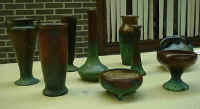 Clewell
did not share how to achieve these patinaed colors with anyone. And no one has
since replicated Clewell's work, His only employee was his daughter, who worked
as his salesperson.
Clewell
did not share how to achieve these patinaed colors with anyone. And no one has
since replicated Clewell's work, His only employee was his daughter, who worked
as his salesperson.
In 1937 Clewell took some of his pieces to the Paris Exposition, where he was
awarded a medal for his efforts.
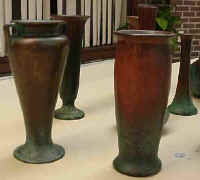 Clewell
production continued throughout his lifetime, with the exception of a 10-year
period; from about 1940-1951 his work was discontinued while he worked for
Timkin Roller Bearing Company. In 1965 at the age of 89, Clewell died. His
daughter is said to have sold his remaining pieces. The Jessie Besmer Museum in
Alpina, Michigan has an exhibit of 90 pieces of Clewell's work.
Clewell
production continued throughout his lifetime, with the exception of a 10-year
period; from about 1940-1951 his work was discontinued while he worked for
Timkin Roller Bearing Company. In 1965 at the age of 89, Clewell died. His
daughter is said to have sold his remaining pieces. The Jessie Besmer Museum in
Alpina, Michigan has an exhibit of 90 pieces of Clewell's work.
Marks on Clewell Pottery: In his book "American Art Pottery", Dick
Sigafoose notes that Clewell pieces are marked with an incised "Clewell,"
an impressed "Clewell Metal Art, Canton 0.," "Clewell
Coppers," Clewell Canton 0.," or a "W" within a letter
"C".
WPA Related Pages:










